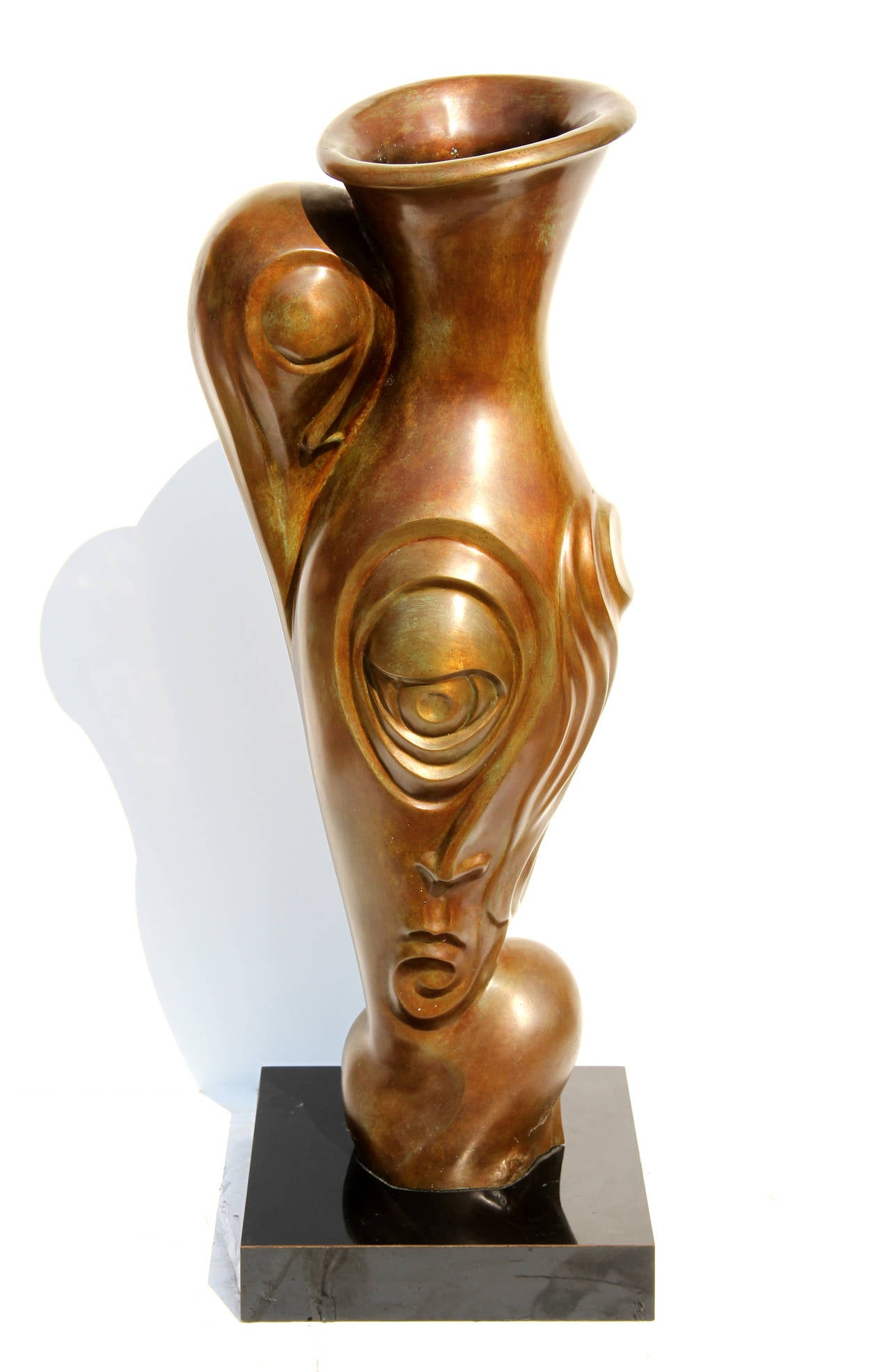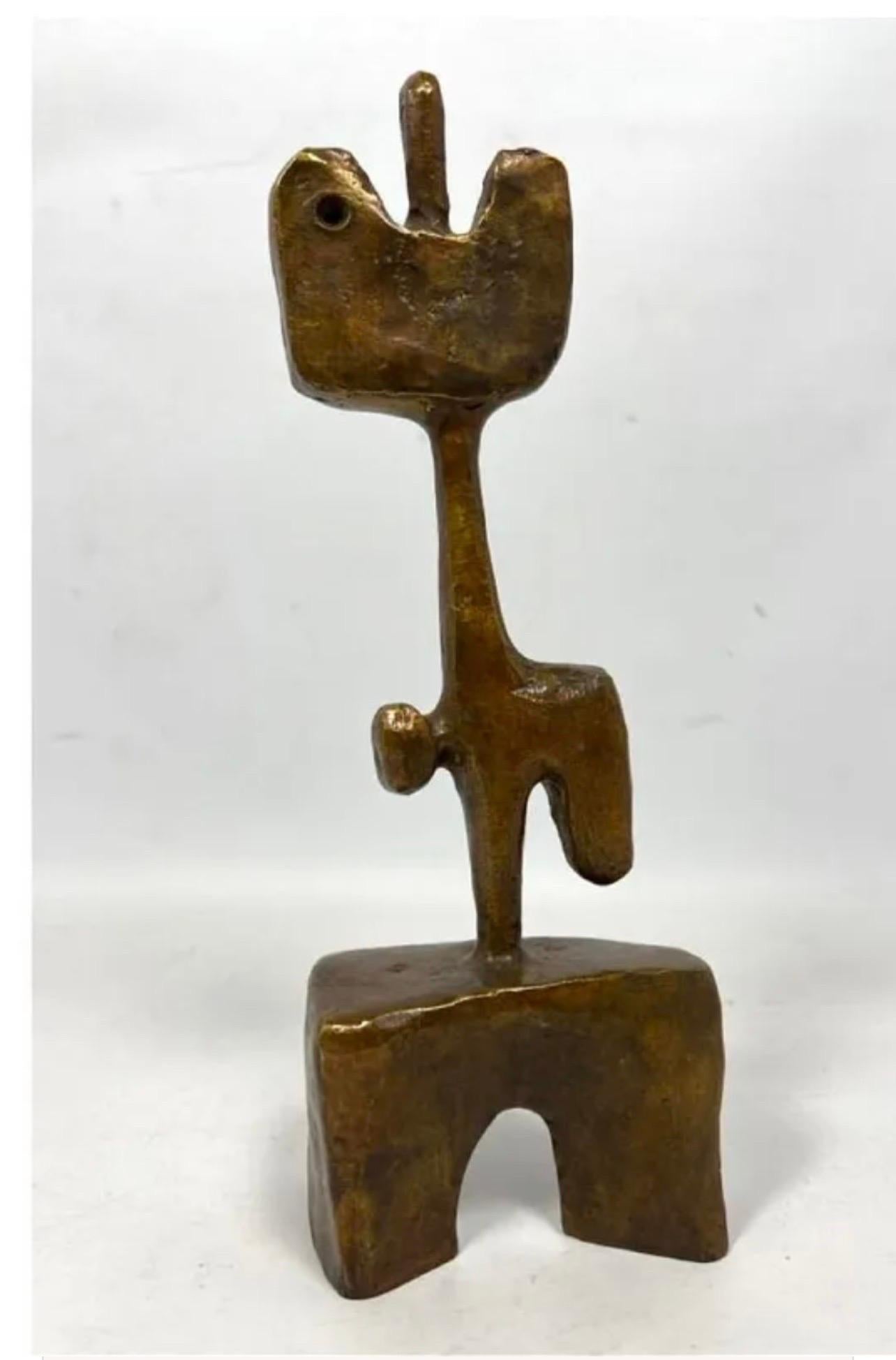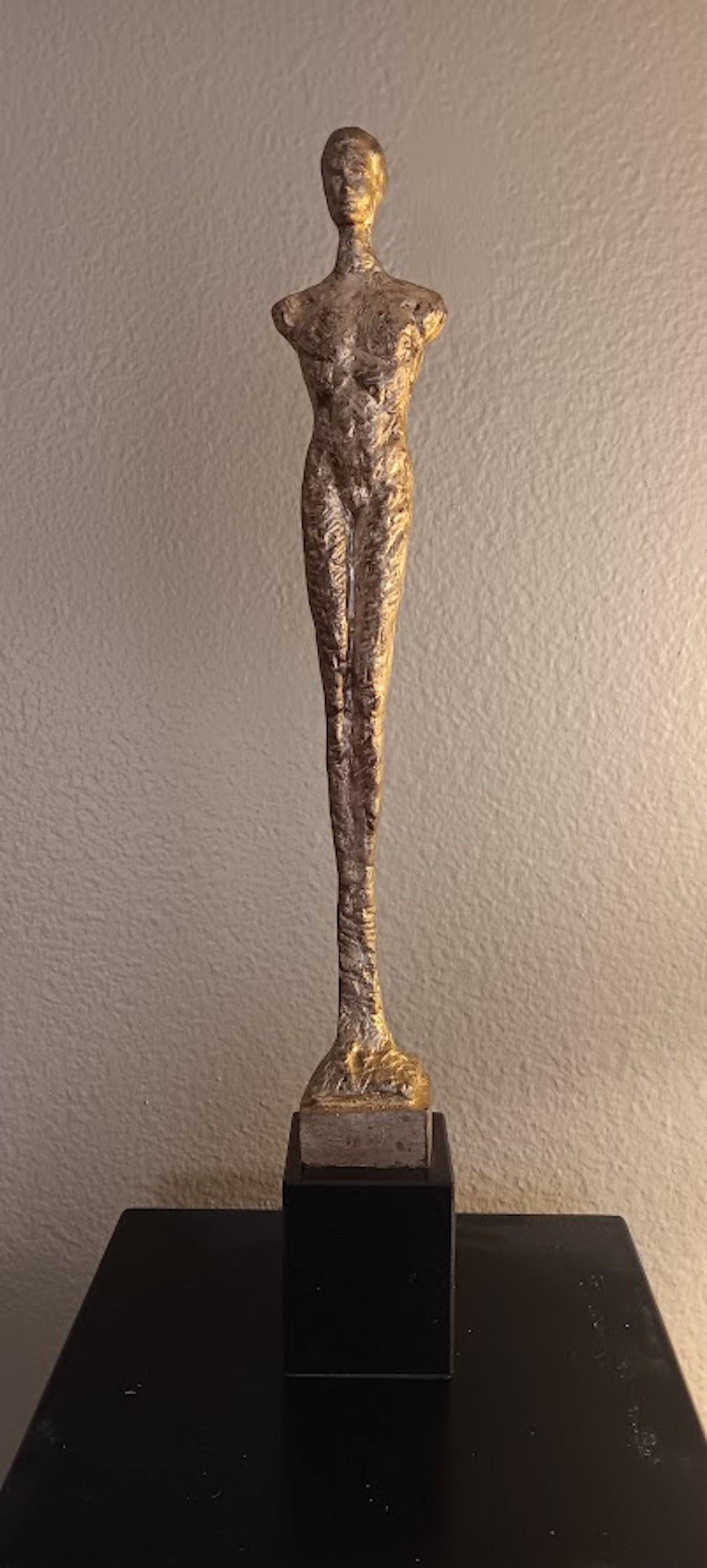Items Similar to Statue of Liberty
Want more images or videos?
Request additional images or videos from the seller
1 of 4
ArmanStatue of Liberty1998
1998
About the Item
Arman Statue of Liberty features a recurring motif in the artist’s body of work. Throughout his career, Arman has worked with themes and techniques of “accumulations” and “deconstructions"—works of art that he either smashed, sliced, or burned. These objects tended to be musical instruments, sculptural reproductions, and even furniture. He began creating his “deconstructions” in 1959 with his violin brules, instruments that he dissected into their wood panels. The motivation behind his artistic action is to suspend the action of deconstruction and control the final stages of an object’s life span. His object oriented approach harkens back to Marcel Duchamp. Yet, Arman differentiates himself by saying, “As I evolved into object art, I found myself being called a pop artist, but the term isn’t exactly right. Pop artists redo the object. I used the real object. Marcel Duchamp, who is the obvious father of object art, might have taken a soup can and put it on a pedestal. Andy Warhol would repaint the soup can. Jasper Johns would cast it in bronze. I’d take the soup can and cut it into pieces or weld hundreds of them together in order to change the state of the object from what it was when you first saw it in the supermarket. My interest is in exploring the various worlds of the object."
This unique view of the Statue of Liberty entices the eye to explore its many layers of diverse perspectives in interpretation. Each piece of the original statue is divided and staggered, retaining its original form despite the image of deconstruction. Sitting atop her head is her famous gold crown. The torch in her right hand is also colored with a brilliant gold sheen. Throughout the colors, one can still discern the intricate folds of her robe and the details of her costume. Her facial features are subtly discernible, encouraging a closer study.
This cast bronze sculpture with green oxidized patina is an artist’s proof, numbered from the edition of 20; aside from the numbered edition of 100.
- Creator:Arman (1928 - 2005, French)
- Creation Year:1998
- Dimensions:Height: 30.7 in (77.98 cm)Width: 13.4 in (34.04 cm)Depth: 3.9 in (9.91 cm)
- Medium:
- Movement & Style:
- Period:
- Condition:
- Gallery Location:Palo Alto, CA
- Reference Number:
Arman
Arman was born in Nice, France, in 1928, and showed a talent for painting and drawing as a child. He studied at the the Ecole Nationale des Art Décoratifs in Nice followed by studies at the École du Louvre in Paris. In his early years he focused on abstract paintings. Then, in 1957, he became interested in common objects as works of art. He first did what came to be called his "allures d"objet" (object impressions), where he would dip an object into paint and press it on canvas thus leaving the object's shadow or impression. Then he decided the object itself was worth paying attention to and started to treat them in his own way. His intention was to remove the material purpose of an object so that its only remaining function was to "feed the mind" as a work of art. What better way to achieve that result than by breaking, slicing or even burning objects such as violins, telephones, typewriters or even whole cars? He also made objects useless by accumulating them, such as 2,000 wristwatches in a Plexiglass box that all kept different time. Once emotionally detached from the circumstances associated with a broken object, the viewer could grow to appreciate its abstract beauty; so, in a sense, Arman was literally teaching that things one never thought could be regarded as attractive could indeed turn out to be so. Through this achievement, Arman gained worldwide recognition and is regarded as one of the most prolific and inventive creators of the late 20th century. His work can be found in the collections of numerous museums including the Metropolitan Museum of Art in New York, the Tate Gallery in London and the Centre Pompidou in Paris. Arman’s work has also been exhibited in galleries, museums and public spaces worldwide including the Musée D’Art Contemporain in Tehran, Iran; the Museum of Art in Tel Aviv, Israel; the Musée Des Arts Decoratifs and Opéra De Paris in France; the La Jolla Museum of Contemporary Art in California; and the Museum of Arts and Design and the Guggenheim in New York He died in 2005 in New York.
About the Seller
5.0
Vetted Seller
These experienced sellers undergo a comprehensive evaluation by our team of in-house experts.
1stDibs seller since 2021
22 sales on 1stDibs
Typical response time: 5 hours
- ShippingRetrieving quote...Ships From: Palo Alto, CA
- Return PolicyA return for this item may be initiated within 7 days of delivery.
More From This SellerView All
- Wizzard, 1978By Karel AppelLocated in Palo Alto, CADating from 1979, this acrylic on wood relief is hand-signed 'Appel' by Karel Appel (Amsterdam, 1921 - Zürich, 2006) in red in the lower left. From an edition of 8, this work was pub...Category
1970s Modern Figurative Sculptures
MaterialsAcrylic, Wood
- Face, 1968-1969By Pablo PicassoLocated in Palo Alto, CAA whimsical portrait in vivid colors, this work appeals to our response to color, texture, depth and space. There is a wonderful interplay between ...Category
1960s Modern Figurative Sculptures
MaterialsEarthenware, Glaze, Clay
- Picador, 1953 A.R. 200By Pablo PicassoLocated in Palo Alto, CACapturing the moment in which the picador stabs the charging bull with his lance, Picasso creates an image of action and suspense in Pablo Picasso ceramic Picador...Category
1950s Modern Figurative Sculptures
MaterialsEarthenware
- Arrastro, from Service Scènes de Corrida, A.R. 423By Pablo PicassoLocated in Palo Alto, CACreated in 1959, Pablo Picasso Arrastro, from Service Scènes de Corrida A.R. 423 is numbered from the edition of 50 on the reverse and stamped with the 'MADOURA PLEIN FEU' and ‘EMPRE...Category
1950s Modern Figurative Sculptures
MaterialsEarthenware, Ceramic, Glaze
- Paseo & Arrastro, from Service Scènes de Corrida (Set of 2), A.R.416 & A.R.423By Pablo PicassoLocated in Palo Alto, CACreated in 1959, Pablo Picasso (Málaga, 1881 – Mougins, 1973) Paseo A.R. 416 and Arrastro A.R. 423 are numbered from the edition of 50 on the reverse and stamped with the 'MADOURA PLEIN FEU' and ‘EMPREINTE ORIGINALE DE PICASSO' pottery stamps on the reverse. Pablo Picasso was an avid fan of bullfighting his entire life, attending his first corridas when he was a child in Spain and gaining a renewed interest in the events when he settled in the South of France after World War II. Undoubtedly the theatrical drama and flashy machismo of the matadors appealed greatly to Picasso's sensibilities and resonated with his Spanish roots. In 1959, Picasso produced an 8-piece plate series, each featuring a different bullfighting scene suggested through lively stipple lines. Paseo A.R. 416 depicts a line of bullfighters highlighted by a streak of yellow. The strokes of blue above and below the figures contrast with the warm of the yellow, creating visual tension that anticipates the drama of the fight. Arrastro, from Service Scènes de Corrida, 1959 A.R. 423 features a victorious bullfighter holding his curved sword, known as an estqoue, over his head. The dark atmosphere created by the deep blue, black, and touch of brown is slashed by the intense yellow down the center of the plate. This shock of bright color evokes the excitement of the bullfighter as he stands triumphant over the bull. Catalogue Raisonné & COA: Pablo Picasso Paseo...Category
1950s Modern Figurative Sculptures
MaterialsCeramic
- Petite tête, profil gauche (Small Head, Left Profile), A.R. 535By Pablo PicassoLocated in Palo Alto, CACreated in 1965, this terre de faïence sculpture with white slip is inscribed on the sculptural base with the atelier stamps ‘EDITION PICASSO’ and ‘MADOURA...Category
1960s Modern Figurative Sculptures
MaterialsSlip, Faience
You May Also Like
- Show of InterestBy Brad RudeLocated in Denver, COArtist Brad Rude was born in Montana and has lived in Walla Walla, Washington most of his life. His journeys through his grandfather's folk art studio left...Category
2010s American Modern Figurative Sculptures
MaterialsEnamel, Bronze
- Profile Pitcher, Cubist Bronze VaseLocated in Long Island City, NYArtist: Unknown, possibly Russian Title: Profile Pitcher Medium: Bronze Sculpture with Patina Size: 26.5 in. x 9 in. x 5 in. (67.31 cm x 22.86 cm x 12.7 cm) Base: 2.5 x 10.5 x 10.5 i...Category
20th Century Modern Figurative Sculptures
MaterialsBronze
- Mexican Art Abstract Brutalist Biomorphic Bronze Sculpture Mathias GoeritzBy Mathias GoeritzLocated in Surfside, FLMathias Goeritz (German Mexican, 1915-1990) Bronze sculpture Signed and numbered Dimensions: (approximate) Height: 10 inches, Width: 4 inches, Depth: 2 inches. This is a cast bronze sculpture in an amorphous figure shape, quite heavy. Reminiscent of the biomorphic sculpture of Hans Jean Arp. This came from an estate and bears his signature It is not dated. there is no accompanying documentation. it is priced accordingly. Werner Mathias Goeritz Brunner (Danzig, Germany, April 4th, 1915/ now Gdansk, Poland – Mexico City, Mexico; August 4th, 1990). Mathias Goeritz has had several gallery and museum exhibitions, including at the Museo Nacional Centro de Arte Reina Sofía and at the Museo Experimental El Eco. Numerous works by the artist have been sold at auction, including 'MENSAJE' sold at Sotheby's New York 'Latin American Modern Art' in 2015 for $466,000. There have been Several articles about Mathias Goeritz, including 'LACMA remaps Latin America' written by Suzanne Muchnic for the Los Angeles Times. Painter, sculptor and Mexican architect associated with the trend of constructive abstraction. He studied medicine at the University of Berlin, but this only lasted a year. The concerns of the young student were aesthetic in nature so he he studied figurative drawing at the Berlin Charlottenburg School of Art. Some of his friends and colleagues were the sculptor Ernst Barlach, painter George Grosz and draughtsman Kaethe Kollwitz. Goeritz studied philosophy and history of art, discipline in which earned a doctorate. He travelled in France, Switzerland, Czechoslovakia, Poland, Austria and Italy, among other countries. It is known that he left Germany to live in Tetuan, Morocco in 1941 and then Granada, Spain in 1945. In 1946 he had a large exhibition in the Sala Clan in Madrid under the pseudonym "Mago". Two years later, living in Santilla del Mar, Spain he was a founder of the Escuela de Altamira. The following year he married Marianne Gast, writer and his companion for more than fifteen years. In Spain followed his artistic work by important artists of the avant-garde. Of Jewish descent, he found refuge from the Second World War in Mexico where in 1949 he was invited by Ignacio Diaz Morales to be a part of the faculty of the School of Architecture at the Universidad de Jalisco. In 1953 he wrote the "Manifiesto de la Arquitectura Emocional" (The Emotional Architecture Manifesto), where he points out that only achieving true emotions from architecture can it then be considered an art form. In Mexico he entered controversy with the artistic stablishment of that country; in an open letter, Diego Rivera and David Alfaro Siqueiros described him as "an impostor without the most insignificant talent and preparation" to be an artist. Despite this, in 1957 he was elected director of visual design of the National School of architecture This same year he founded the Museo del Eco in Mexico City. In 1961 Goeritz participated at the Galería Antonio Souza in a group exhibition, Los hartos, for which he published another manifesto. Other participants included Jose Luis Cuevas and Pedro Friedeberg, with whom he was instrumental in establishing abstraction and other modern trends in Mexico.His work is included in the Gelman Collection of modern and contemporary Mexican art based in Cuernavaca, Mexico. Established by Jacques and Natasha Gelman in 1943 as a private collection. it includes many iconic works by major Mexican Modernists including Frida Kahlo, Diego Rivera, David Alfaro Siqueiros, Leonora Carrington, Rufino Tamayo and Francisco Toledo, Lola Alvarez...Category
20th Century Modern Abstract Sculptures
MaterialsBronze
- "Zeke & Zach 11/18" Abstract Figurative Bronze sculpture of a man and horseBy Wayne SalgeLocated in Edgartown, MAThe historic tradition of cast bronze provides a contemporary avenue for the creation of Wayne Salge’s abstracted human and animal figures. Thoroughly modern and distinctly impressio...Category
2010s Modern Figurative Sculptures
MaterialsBronze
- After Alberto Giacometti, Man Standing Up, Bronze FigureBy Alberto GiacomettiLocated in Pasadena, CAModern bronze with gold patina figural sculpture, in the style of Alberto Giacometti (Swiss, 1901-1966), not signed, depicting abstract nude male a figures, in a parcel gilt finish, ...Category
1950s Modern Figurative Sculptures
MaterialsBronze
- Équilibre d'éléphants ( mod.01 )Located in Villafranca Di Verona, ITNumbered and limited to 45 copies ( 30 + 15 P.A ) Artwork signed Authenticity: Sold with certificate of Authenticity from the gallery Invoice from the gallery Sculpture: bronze, met...Category
2010s Modern Figurative Sculptures
MaterialsBronze





